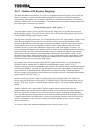
G7 ASD Multi-Protocol Communication Option and PG Feedback Option Manual
34
9.6.3 Drive Parameter Access Procedure
In order to read from a drive parameter or write to a drive parameter, two control bits are provided in
the drive’s output data structure. These bits, labeled Req1 and Req0 in the Action Bits word, can have
the following values:
Req1
Req0
Meaning
0 0.............. No action (idle state)
0 1.............. Parameter read
1 0.............. Parameter write (RAM & EEPROM)
1 1.............. Parameter write (RAM only)
Similarly, when the drive responds to a parameter read or write request, two status bits are provided in
the drive’s input data structure. These bits, labeled Resp1 and Resp0 in the Action Bits Response word,
can have the following values:
Resp1
Resp0
Meaning
0 0.............. No action (idle state acknowledge)
0 1.............. Parameter read success acknowledge
1 0.............. Parameter write success acknowledge
1 1.............. Error indication
Note that the Multicom interface will respond with Resp1:Resp0 = 1:0 upon a successful parameter
write, regardless of whether the write was to RAM & EEPROM or to RAM only.
Performing a parameter read or write action from the Profibus master involves the following process:
1. Send a “no action” code (Req1=0 and Req0=0). Every parameter access must begin from the
idle state. Once this state is sent, the Profibus master must then wait for the Multicom interface
to respond with an idle state acknowledge (Resp1=0 and Resp0=0).
2. If the action is to be a data write, set the parameter data in the parameter data write word. If
the action is to be a data read, the parameter data write word value is irrelevant.
3. Set the parameter number and action code (Req1 and Req0). For an explanation of parameter
numbers, refer to section 9.7.
4. Once the Multicom interface receives the read or write request, it will begin processing it. The
time required to complete the request depends primarily on the specific register being
requested and the drive’s internal state at the time of the request, but can vary from several
milliseconds to several tens of milliseconds.
5. Once the Multicom interface has completed the request, it will place its response in the action
bits response, parameter number response, and data / error code response locations:
•
If the request was a read, and the read was performed successfully, this will be indicated to the
master by Resp1:Resp0 changing from 0:0 to 0:1. The parameter number response will equal
the accessed parameter number, and the resulting data read will be placed in the data / error
code response word.
•
If the request was a write, and the write was performed successfully, this will be indicated to
the master by Resp1:Resp0 changing from 0:0 to 1:0. The parameter number response will
equal the accessed parameter number, and the data written to the drive will be reflected in the
data / error code response word.
•
If an error occurred during the read or write request, this will be indicated to the master by
Resp1:Resp0 changing from 0:0 to 1:1. The parameter number response will equal the
parameter number that the master was attempting to access, and an error code reflecting the
failure cause will be placed in the data / error code response word. For a list of possible error
codes, refer to section 9.6.4.


















